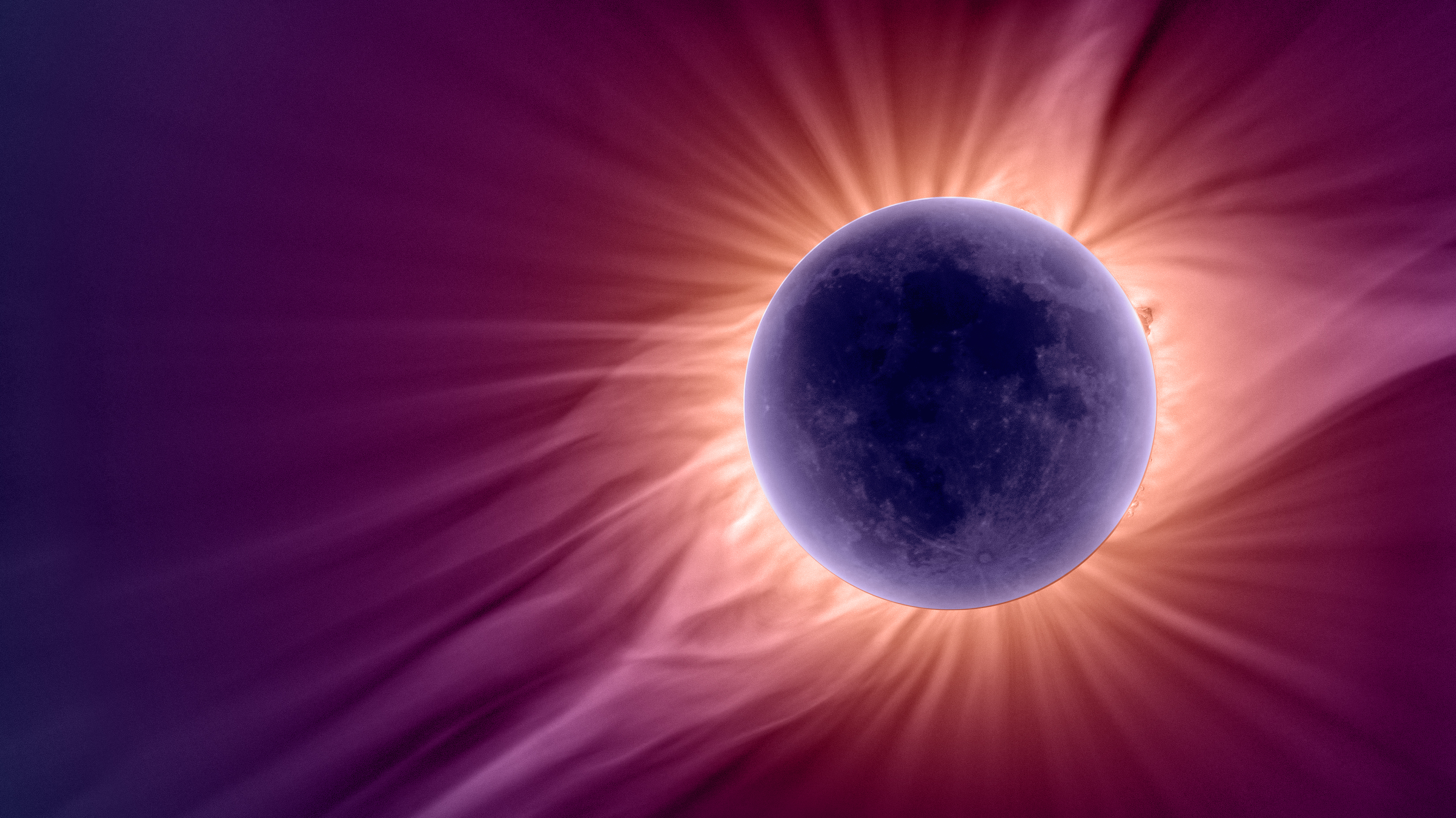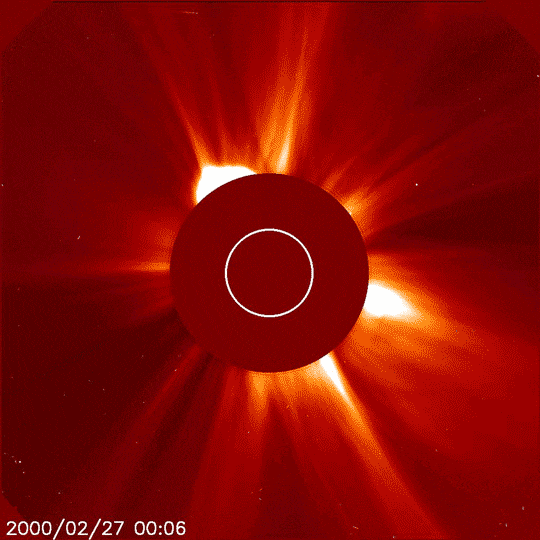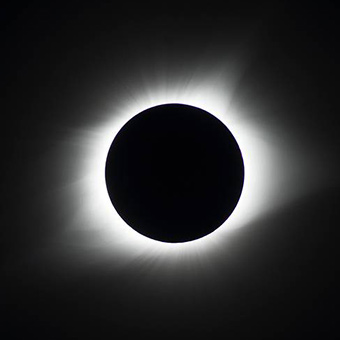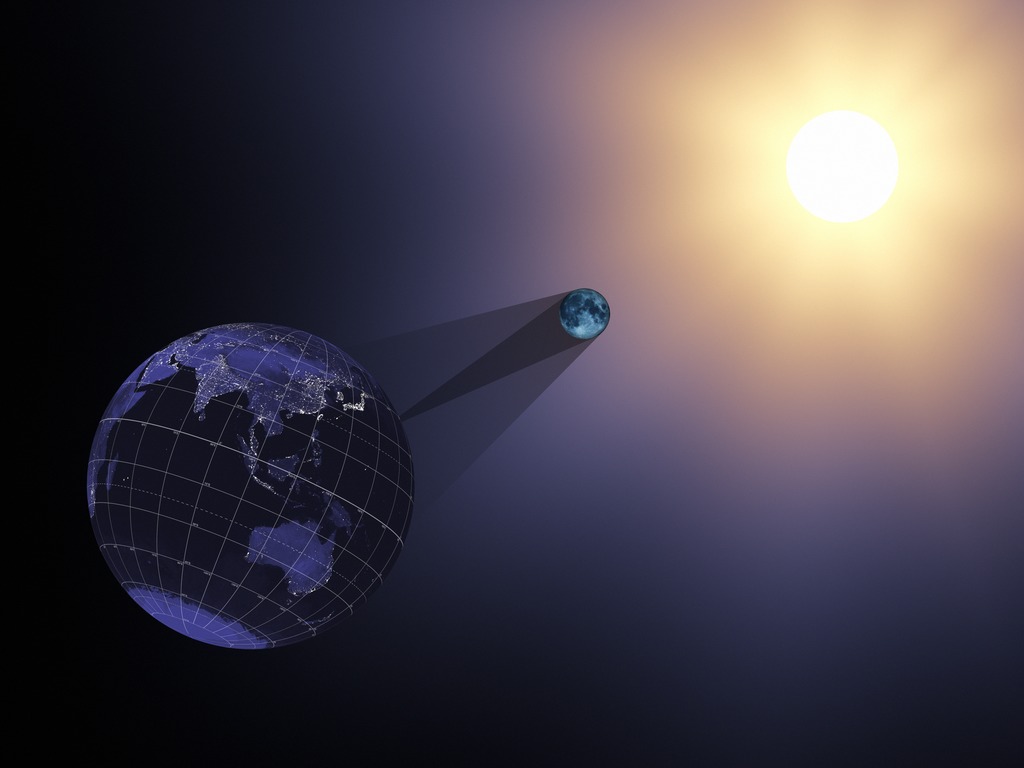A solar eclipse happens when the Moon passes directly between the Sun and Earth. When the Moon completely blocks the Sun, it is called a total solar eclipse. When the Moon only blocks part of the Sun, it is called a partial eclipse. An annular eclipse is s special type of partial eclipse that happens when the Moon blocks all of the Sun except for a small ring around the edge. Sometimes a solar eclipse can appear as an annular in some places and a total in others as the Moon's shadow moves across Earth's surface. This is known as a hybrid eclipse.
To learn more about the types of solar eclipses, please visit the eclipse types page.
Total solar eclipses last anywhere from 10 seconds to about 7.5 minutes. In the span of 12,000 years from 4000 BCE to 8000 CE, the longest total solar eclipse will occur on July 16, 2186, and will last 7 minutes 29 seconds. Its path will sweep across Colombia, Venezuela, and Guyana. The shortest total solar eclipse happened on Feb. 3, 919 CE, and lasted just 9 seconds.
The next total solar eclipse visible from the United States occurs on April 8, 2024. The path of totality goes from Texas to Maine and crosses the path of the August 2017 eclipse near Carbondale, Illinois. Calculations show that it will take about a thousand years for every geographic location in the lower 48 states to be able to view a total solar eclipse.
After 2024, the next total solar eclipse visible from any point in the contiguous United States will occur in 2044. Totality will only be visible from North Dakota and Montana.
The next total solar eclipse that will travel across the lower 48 states from coast to coast is in 2045.
Indirect viewing methods are always appropriate to make observations of our closest star, the Sun. Using a pinhole projector will create an image of the Sun on any surface where you can see the progress of a solar eclipse.
Using solar viewing glasses is appropriate for directly looking at the Sun. You can learn more about this from the American Astronomical Society. NASA does not approve any particular brand of solar viewers.
A properly fitted solar filter is essential to use any sort of magnification, such as for cameras, binoculars, or telescopes.
NASA studies eclipses for multiple reasons.
Studying the innermost part of the corona, the Sun's outer atmosphere – visible only during total solar eclipses – is key to answering fundamental questions about how heat and energy are transferred from the Sun out into the solar wind, the constant stream of particles that the Sun spews into the solar system. The solar wind can impact technology on Earth and astronauts in space, so understanding how it becomes accelerated at the Sun can help predict its impacts at home.
Total solar eclipses provide an opportunity to study Earth’s atmosphere under uncommon conditions. In contrast to the global change in light that occurs every day at dusk and dawn, a solar eclipse changes the illumination of Earth and its atmosphere under a comparatively small region covered by the Moon’s shadow. This localized blocking of solar energy is useful for studying the Sun’s effects on our atmosphere, especially the upper atmosphere, where the Sun’s energy creates a layer of charged particles called the ionosphere. Understanding this region is important because it’s home to many low-Earth orbit satellites as well as communications signals, such as radio waves and the signals that make GPS systems work, and changes there can have significant impacts on our technology and communication systems.
The Moon’s orbit is "tilted" relative to the Sun-Earth line. As a result, sometimes the Moon's shadow is too high above Earth and sometimes it is too low. Other times, it is just right.
Occasionally, dark spots freckle the face of the Sun. These are sunspots, cooler regions on the Sun’s visible surface caused by a concentration of magnetic field lines. Sunspots are the visible component of active regions, areas of intense and complex magnetic fields on the Sun that are the source of solar eruptions.
Lasting from days to months, sunspots typically stretch 1,000 to 100,000 miles across. The number of sunspots goes up and down as the Sun goes through its natural 11-year cycle. Scientists use sunspots to help them track this cycle.
Astronomers first have to work out the geometry and mechanics of how Earth and the Moon orbit the Sun under the influences of the gravitational fields of these three bodies. From Newton's laws of motion, they mathematically work out the motions of these bodies in three-dimensional space, taking into account the fact that these bodies have finite size and are not perfect spheres. Scientists then feed the current positions and speeds of Earth and the Moon into these complex equations, and then program a computer to "integrate" these equations forward or backward in time to calculate the relative positions of the Moon and Sun as seen from the vantage point of Earth.
Eclipses are specific configurations of these bodies that can be identified by the computer. Current eclipse forecasts are accurate to less than a minute in time over a span of hundreds of years.
Eclipses occur in patterns. The Saros Series is a period of 223 lunar months that has been used to predict eclipses for thousands of years. In a Saros Series, exactly 9 years, 5.5 days after any lunar eclipse, a solar eclipse will occur, and vice versa. Approximately 6585.3211 days, or 18 years, 11 days, and 8 hours after one eclipse, the Sun, Earth, and Moon return to about the same relative geometry, and a nearly identical eclipse occurs. These similar eclipses are part of the same Saros Cycle, and the time between the two eclipses is called a saros.
For eclipses that belong to the same Saros Cycle, the Moon will be at the same node and the same distance from Earth. Because one eclipse of a Saros Cycle occurs just 11 days later in the year than the last one, Earth will be at nearly the same distance from the Sun and tilted relative to it in nearly the same orientation (in the same season) as it was during the previous eclipse in that cycle. Each total solar eclipse path of totality looks similar to the previous one, but is shifted by 120 degrees westward.
Earth rotates eastward on its axis, which means the Moon, Sun, and stars appear to move from east to west across the sky. The Moon orbits Earth in the same direction as our planet rotates – eastward – but the Moon’s movement along its orbit is small compared to Earth’s daily rotation, making it difficult to notice the Moon’s eastward motion. However, during a solar eclipse, it is easier to observe this motion as the Moon crosses in front of the Sun from west to east. The Moon’s shadow follows in the same direction, tracing an eastward path across Earth’s surface.





